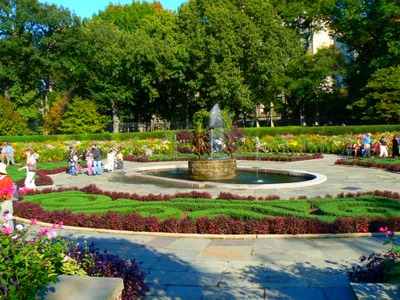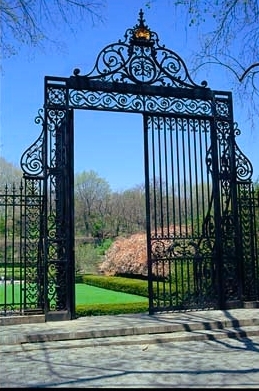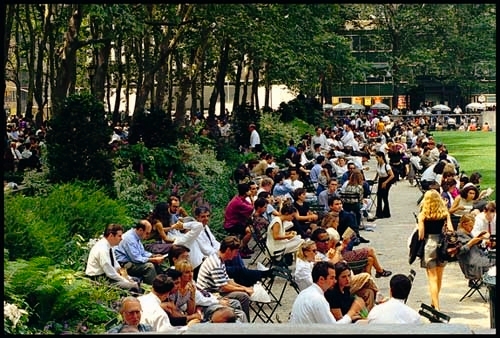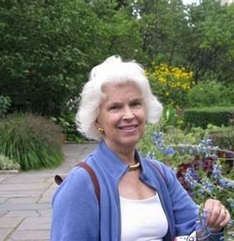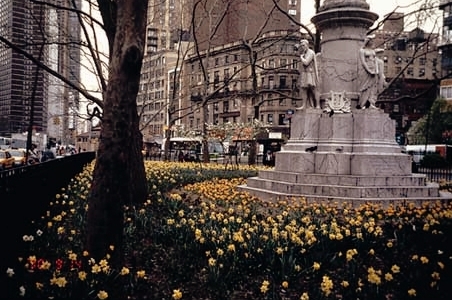
Anyone who has sat in lazy contentment in the lush and leafy 'secret' garden at the northernmost extent of Central Park, a once desolate location where unsuspecting visitors were routinely robbed, knows that a book about Lynden Breed Miller's vital work is long overdue.
Certainly Bette Midler thinks so. She has said in regard to Norton's new Parks, Plants and People, Beautifying the Urban Landscape, which is a kind of illustrated gardening memoir, "It's no exaggeration to call Lynden Miller the god-mother of New York City's public green spaces. This book is a must read."
Concurring, Martha Stewart added, "Parks, Plants and People, Beautifying the Urban Landscape ... makes us understand the importance of public parks ... and makes us look at these spaces with new reverence and appreciation."
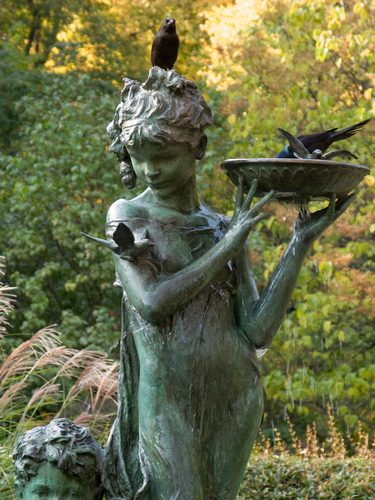
What is a park anyway? Essentially, since medieval times, a park was an enclosed section of ground composed of areas of varied character. Copse, woodland, meadows and marshes, all assured that kings, nobles and other large landowners, could enjoy a wide variety of sporting pursuits, particularly, hunting.
Owning no estates, the non-rich were forbidden to hunt. 'Tenants,' preoccupied farming for their 'landlords,' were disinclined to waste time making pleasure gardens. However the well-to-do, eager to assuage the ennui of excessive leisure with beauty and fragrance, did create gardens which were often environs of infinite delight.
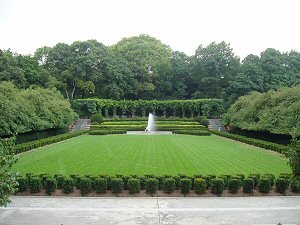
A century ago, emulating this aristocratic European tradition, elite homeowners in the United States also planned great gardens. Featuring broad balustraded terraces, they were graced by handsome statuary, lily pools, marble urns and exuberant fountains. The perfect setting for houses often inspired by castles, chateaux and villas, transversed by grand allées of trees beyond shady glades and flower-fringed lakes; such gardens helped to convince American captains of finance that they too were regal eminences.
In New York since the 1860s, Central Park and other public open spaces have offered some of the same amenities that were once the exclusive province of the affluent and powerful, to residents not fortunate enough to possess their own county house set on rolling acres.
Just as in the best Italian gardens of Gold Coast estates on Long Island's North Shore, Bryant Park's bosquettes of plane trees form a stately backdrop for herbaceous borders below sheltered terraced walks. In Central Park, the Conservatory Garden juxtaposes expansive naturalism with contrasting, highly proscribed spaces, set within an architectural framework of extreme formality. Enclosed flower-filled gardens with precisely clipped hedges adjoin a sunken 'green carpet' of lawn, articulated by pleached crab-apple allées.

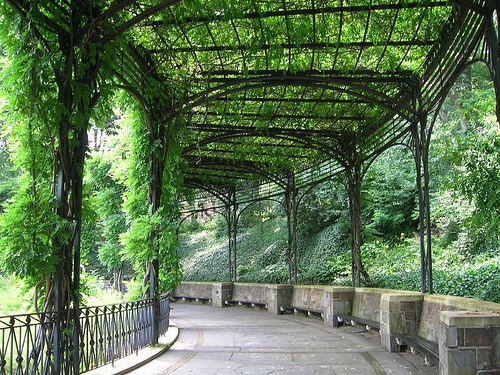
Terminating on a fountain below an exedra-like arched pergola, romantically draped in wisteria, it is a scene derived directly from the early 1900s when America's most lavish country houses boast the most palatial landscapes ever devised here.
As with many private gardens, changed taste and circumstances meant that the time came when these magical public places also became neglected, overgrown, derelict and unsafe. A genteel lady, who's even patrician, yet utterly unassuming too, Lynden Miller seems unlikely in the role of savior. That more than any other New Yorker she has largely reversed the ill effects of the city's 1970s era of disinvestment in public places is indisputable. Stressing public service and maintaining an un-showy demeanor, she makes a privileged existence, including, from birth, enrollment in the Social Register and education at Smith College, a life that's lived in a Fifth Avenue apartment and a Sharon, Connecticut country place, seem 'ordinary,' as indeed it is, among certain people.
Still, notwithstanding an illustrious lineage and fashionable addresses, Lynden Miller is not rich. So a certain amount of her time over the past quarter century, has been devoted to seeking funders and cultivating volunteer laborers.
Easily formulating subtly colored borders of flowers, foliage and shrubbery, worthy of England's Gertrude Jekyll, schemes that readily betray her initial training as a painter, it's the generosity of Lynden Miller's friends which has crucially helped to bring her inspired visions into being.
All the same, called upon to lend her talents to giving deprived uptown parks the same sort of artful treatment she's paid handsomely to produce downtown, Miller always finds a way to help. That's why in Harlem, at the center of Broadway, malls are softened by the same hardy and abundant, sweetly scented yellow roses Miller also specified for plots on Columbia University's campus.
It's amusing recalling how those roses arrived at Columbia. Heading both the Park's and the Landmark's Committees of Community Planning Board Number Nine, my friend Carolyn Wade Kent ...
... was an East Coast matron with a penchant for public service and an elite heritage, similar to Miller's. Indeed it can even be said that what Miller accomplished downtown, Kent achieved in Morningside Heights and West Harlem. How I resisted Carolyn's entreaties to work on the community board, considering such entities to be the most raucous, undisciplined and combative form of government imaginable. "That's just because they're the most directly representative and democratic," Carolyn had sniped, and so, won me over.
Participating in the board's work was one thing, but working with Columbia was quite another entirely. After going to graduate school there in the nation's oldest historic preservation program, learning just how indifferent Columbia was to historic preservation and community outreach alike, I was leery of wasting time.
One singular trait which women like Carolyn Kent and Lynden Miller share is their dogged faith that if one is direct, honest and sincere, 'nice people' will respond in kind. This assumption is neither tinged with condescension nor corrupted by elitism. To these women, all sorts of unlikely people are assumed to be 'nice.'
The beauty of their 'unrealistic' attitude is that it frequently challenges people to be far 'nicer' and more sincere than they had intended to be. At Columbia, Emily Lloyd, the vice president for community relations, assembled a planning advisory group that included Carolyn and me along with Lynden Miller. We had never met, but Carolyn knew of Miller through the parks committee.
Deciding to start out acting as if Columbia was serious about soliciting our views for improving their campus, we suggested a series of preservation initiatives and policies. Unaware that she had previously served on Boston's Landmarks Commission, how surprised I was when Lloyd agreed with us!
'Carolyn, she's for real', I whispered in a gasp. "Yes!", Carolyn answered knowingly. 'Should I recommend that in restoring the grounds that they should look at the remarkably beautiful transformations of Bryant Park, the Conservatory Garden and at Battery Park along the waterfront?' "Yes, you ought too." She said.
Carolyn must have known all along that Lyndon Miller was responsible for each of the landscapes that I praised so profusely, that Mrs. Miller felt compelled to disavow that I was not a plant in her employ. And, that was the start of several collaborative efforts uptown.
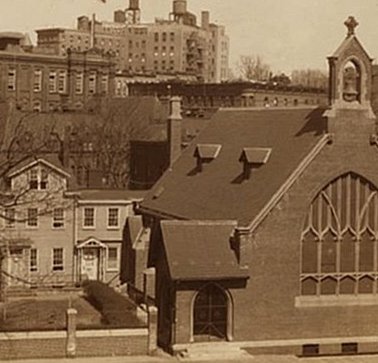
On Friday, November 6, 2009, Carolyn Kent's memorial service, commemorating a well-spent life of caring service, will be held at 11 a.m. at historic Saint Mary's Church Manhattanville. Carolyn's hard work was crucial in getting this extraordinary building protected by landmarking. But in intervening years the garden beside the church and the quaint wood-framed rectory from 1851, has declined into a barren tangle of sickly plants. As community people mount a campaign to restore this oasis as a living monument to Carolyn, how fitting that her friend, colleague and kindred public servant, Lynden Miller has agreed to help assure that it's as nice a garden as any found on an estate at Newport.
